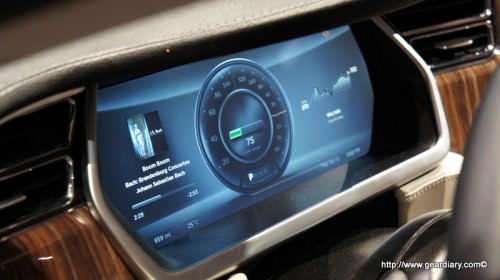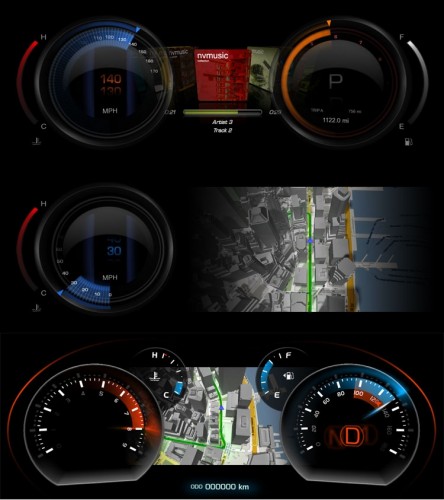?

?
Infotainment you say? It?s about time the big auto manufacturers brought some cool tech into the automobile industry. While third-party car audio fights to stay ahead of the curve, the auto industry has started adding some killer tech into the cockpits today?s vehicles. While built-in nav is nice to have, I find it lacking compared to most third-party add-ons. With the help of the mobile world, things are looking better. Cadillac has a really cool commercial showing off their latest model the XTR, which touts a killer touch screen display with some features that a tablet loving consumer base has been wanting for some time. Most vehicles now offer some sort of built-in nav,?Bluetooth, and auxiliary or ?i? device connection off the assembly line. This technology has exponentially improved over time, it seems that it still has not hit mainstream commuting.
With mobile broadband getting more affordable and coverage improving, it won?t be too long before most vehicles offer some sort of?onboard?hotspot. Some really cool things are on the horizon, but will they become affordable enough to entice consumers into adding a few more bills to their sticker price? We all know that Nvidia powers some of the top phones and tablets on the market today, but they are taking the power of the Tegra a step further and integrating it into vehicle cockpits. In the past few years they have been working with some top automakers to take the Tegra based chipsets and put them into your digital dashboard. Audi, BMW, and Tesla motors are already offering some Tegra packed vehicles, and from the previews we saw at CES, the future is looking nothing short of stellar.
Nvidia Tegra Visual Computing Module (VCM)
This unique platform gives automakers a fast, easy way to integrate the most recent automotive-grade?Tegra processor?into their vehicles. NVIDIA VCM is a flexible design approach that dramatically closes the technology gap between consumer electronics and in-vehicle systems.

?
Nvidia took the multi-core power of the Tegra chipset, and created an automotive grade package called the VCM. This chipset is designed solely for the auto industry, and it adds some killer processing power and graphics into a vehicle infotainment system. Not only will this technology allow the in-vehicle nav systems to catch up to latest in mobile technology, but it can turn the entire cockpit into a cutting edge visual driving experience. Maps, info, safety, audio, video, and voice communication are just scratching the surface of what this technology will allow. Imagine home theater quality movies in the back of your mini van or SUV, or a driver information system that audibly and visually alerts you of driving hazards ahead. How about customizing your dash to a handful of gauge cluster types, or changing the lighting and look of your whole dash with your mobile phone or a few taps on your touchscreen.
Digital Gauge Clusters
?Traditional analog gauges and dials are going digital and demanding the highest levels of fidelity. At the same time, the information displayed in the center stack and instrument cluster are starting to merge, placing very high demands on the cluster graphics system.

?
Nvidia offers to the tools to make some insanely cool dash clusters, the UI Design Composer is a custom?development?tool that brings it all to life . If you hit the link on the Nvidia ?site all you get is a big ?contact us? button which is about it when it comes to any info on the software. They do however have some excellent renderings and an amazing video on with some live stuff that they created. Imagine getting in your car and deciding what dash you want to look at that day. Sort of like your smartphone theme or UI where you can mix and match, download new skins, and change things around however you like. You could have a his and hers dash, or maybe go retro with your vintage dash from the 50?s with built-in phone list, music player and mini Nav. It looks like the possibilities are endless.
Here are a few renderings of some dash samples.
?

Image courtesy of Nvidia?
Navigation
Realistic 3D maps and terrain. Snappy, responsive user interfaces. Rich audio. NVIDIA processors power the industry?s most advanced in-vehicle infotainment (IVI) systems.
NVIDIA enhances the driving experience with rich, easy-to-read graphics and premium audio interfaces, from 3D navigation with intuitive, glanceable displays, to natural voice recognition and interactive cockpit controls.

Tesla S 17? Touchscreen
In the past few years, I think that Garmin, Magellan, and TomTom took pretty big hits due to large display phones and killer apps taking over navigation duties. As you know, any Android phone has the ability to run Google Maps, arguably one of the best nav programs on the market. Best of all, it?s free. Apple is no slouch either with their new built-in nav system included in iOS6. Even Nokia and Windows Phone 8 have NAVTEQ onboard, so no matter what smart phone you have, the GPS options ?can easily top that of a stand-along dash mount unit. This is bad news for third-party navigation companies, and may even hinder some people from purchasing the nav package when buying a new car. As you can see in the Tesla picture below, a 17? Google Earth driven display certainly blows your 4-5? ?phone GPS out of the water.
Driver Warning Systems
The tremendous visual processing power of NVIDIA processors will fundamentally change the way people drive. In fact, it will redefine traffic sign recognition, blind spot detection, and lane-departure warnings, as well as driver-alertness monitoring, assisted parking, and night vision.

?Pedestrian Detection, Image courtesy of Nvidia
I saw in a recent Cadillac commercial how the driver?s seat would vibrate when something was in a blind spot or in the way. Passenger safety has always been a number concern for automakers, and the inclusion of all this cool technology usually just makes it more difficult for the driver to pay attention to the road. Nvidia wants to aid the driver with safety using camera and sensors to help raise your awareness of things around you. Some of the key features they talk about are pedestrian detection, road sign detection, and night vision. I believe most safety issues when driving come from people not paying attention, this system may in fact give you an early warning and aid in preventing accidents before they happen.
After seeing this in action at CES and searching around on some car manufacturer websites, the only question I have is when will I be able to get it without taking out a second mortgage on my house? The price of luxury vehicles today is evident that even in a ?recession? like economy, there are still plenty of people willing to spend the money on finest vehicles money can buy. As with any technology, I would imagine prices will drop as time goes on and manufacturing processes improve. Hopefully other vehicles manufacturers will incorporate this technology into some more economical vehicles that the majority of consumers can afford. I don?t know if this will be specific to certain car makers or not, but I assume other companies will catch on and offer similar in dash systems at a more competitive price.
For now I?ll just stick to building my Tesla S on the website while trying to scheme up a way to come up with an extra $80K to build the electric car of my dreams. Some people install their tablets into their dash which is pretty cool, but a Jarvis like brain and maybe a flux capacitor helping me to get from point A to point B would make my commute all that much more enjoyable.
Via Nvidia Automotive
For more information, check out:
Tesla Model S
2012 BMW Article
pierre thomas beyonce gives birth portlandia kelly clarkson playoffs empty nest nbc sports
No comments:
Post a Comment